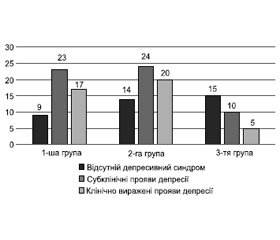Международный неврологический журнал Том 18, №7, 2022
Вернуться к номеру
Немоторні симптоми в структурі проявів різних клінічних форм хвороби Паркінсона на фоні леводопатерапії
Авторы: Таряник К.А., Шкодіна А.Д., Литвиненко Н.В., Пурденко Т.Й.
Полтавський державний медичний університет, м. Полтава, Україна
Рубрики: Неврология
Разделы: Клинические исследования
Версия для печати
Актуальність. Немоторні симптоми хвороби Паркінсона розвиваються в структурі клінічної картини захворювання й залежать від типу обраної терапії. З огляду на той факт, що захворювання завжди розглядається як моторний дефіцит, а вираженість немоторних симптомів залишається недостатньо вивченою, метою нашого дослідження була оцінка вираженості немоторних симптомів при різних клінічних формах хвороби Паркінсона на фоні леводопатерапії. Матеріали та методи. Нами було обстежено 107 пацієнтів із хворобою Паркінсона, які перебували на обстеженні й стаціонарному лікуванні в неврологічному відділенні Комунального підприємства «Полтавська обласна клінічна лікарня ім. М.В. Скліфосовського Полтавської обласної ради» і на базі Центру для пацієнтів із хворобою Паркінсона та іншими нейродегенеративними захворюваннями на базі кафедри нервових хвороб Полтавського державного медичного університету. Були виділені акінетико-ригідна, змішана й контрольна група пацієнтів, які були порівнянні за соціодемографічними показниками, також не було встановлено відмінностей за тривалістю захворювання й локалізацією дебюту. Результати. У групах пацієнтів встановлено вищі показники вираженості немоторних ознак за підшкалами «сон/втома», «настрій», «увага/пам’ять», «гастроінтестинальні порушення», «розлади сечовидільної системи», «порушення статевої функції» порівняно з контрольною групою. Виявлено, що для пацієнтів з акінетико-ригідною формою захворювання характерне переважання розладів з боку гастроінтестинальної і сечостатевої систем, а також порушення сну, психіки й настрою, що виражається загальним балом за шкалою немоторних проявів порівняно з пацієнтами змішаної групи. Встановлено схильність пацієнтів із хворобою Паркінсона до більш вираженого депресивного синдрому порівняно з особами відповідного віку й переважання тривожного синдрому в пацієнтів з акінетико-ригідною формою захворювання — характерні клінічно виражені прояви тривоги, а для змішаної групи — субклінічні прояви. Висновки. На фоні лікування препаратами леводопи в пацієнтів із різними формами хвороби Паркінсона спостерігається значна кількість немоторних симптомів, зокрема порушення сну, психіки, сечостатевої і гастроінтестинальної систем. Пацієнти з акінетико-ригідною формою мають більш виражені немоторні симптоми й розлади афективної сфери.
Background. Non-motor symptoms of Parkinson’s disease develop in the structure of the clinical picture of the disease and depend on the type of therapy. Given the fact that the disease is always considered as a motor deficit, and the severity of non-motor symptoms remains insufficiently studied, the objective was to evaluate the severity of non-motor symptoms in various clinical forms of Parkinson’s disease on the background of levodopa therapy. Materials and methods. We examined 107 patients with Parkinson’s disease who were undergoing examination and inpatient treatment at the neurological department of the Communal Enterprise “Poltava Regional Clinical Hospital named after M.V. Sklifosovsky of Poltava Regional Council” and at the premises of the Center for patients with Parkinson’s disease and other neurodegenerative diseases on the basis of the Department of Nervous Diseases of the Poltava State Medical University. An akinetic-rigid, mixed and control group of patients were selected, they were equivalent in terms of sociodemographic indicators, and no differences were established in the duration of the disease and the localization of the onset. Results. In the groups of patients, higher indicators of the severity of non-motor symptoms were established on the subscales “sleep/fatigue”, “mood”, “attention/memory”, “gastrointestinal disorders”, “disorders of the urinary system”, “sexual dysfunction” in comparison with the control group. It was found that patients with an akinetic-rigid form of the disease are characterized by a predominance of gastrointestinal and genitourinary diseases, as well as sleep, mental and mood disorders, which is expressed by the total score on the scale of non-motor manifestations in comparison with patients of the mixed group. The predisposition of patients with Parkinson’s disease to a more pronounced depressive syndrome compared to people of the corresponding age was revealed, and the predominance of anxiety syndrome in those with an akinetic-rigid form of the disease: clinically expressed manifestations of anxiety are characteristic for them, and subclinical manifestations — for the mixed group. Conclusions. Against the background of levodopa treatment, patients with various forms of Parkinson’s disease have a significant number of non-motor symptoms, including sleep, mental, genitourinary and gastrointestinal disorders. Patients with an akinetic-rigid form have more pronounced non-motor symptoms and disorders of the affective sphere.
хвороба Паркінсона; леводопатерапія; немоторні симптоми
Parkinson’s disease; levodopa therapy; non-motor symptoms

